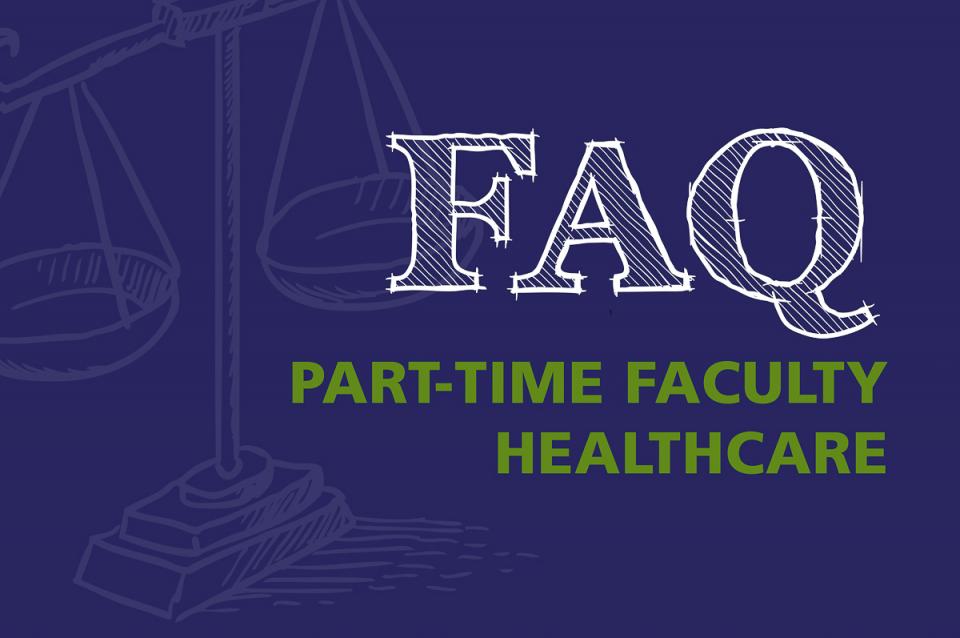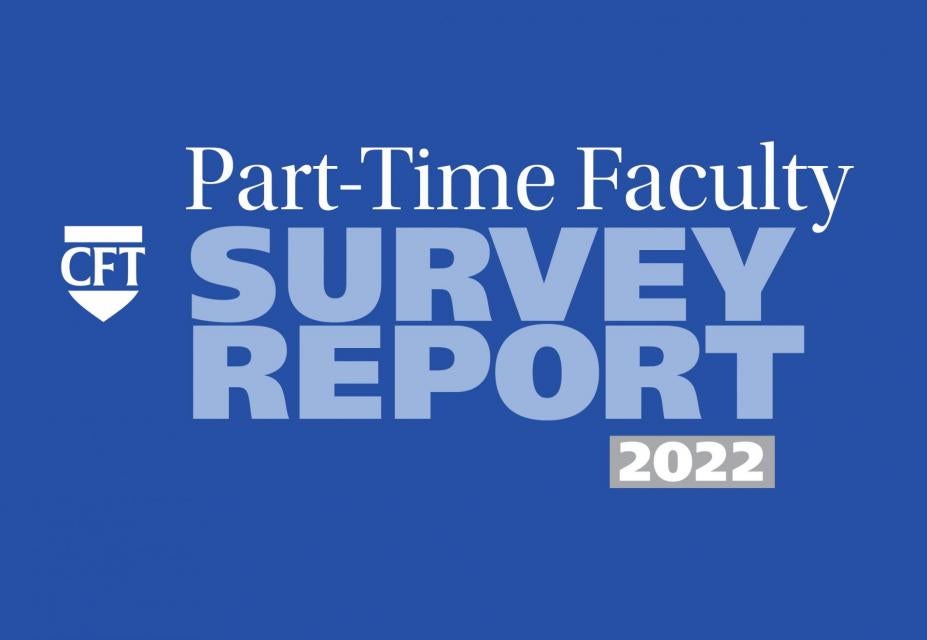Updated September 27, 2022
This year we won a historic expansion of state funding for part-time community college faculty healthcare, increasing state support from $490,000 to $200 million in ongoing funding.
The funding will enable local community colleges to provide quality, affordable, and accessible healthcare to substantially more part-time faculty. Local unions should now prepare to go to the bargaining table to negotiate the healthcare implementation.
This Q&A is meant to help local leaders better understand how the program works and what steps they need to take to secure the improved healthcare for their part-time faculty members.
- For more information, visit our Campaign for Part-Time Faculty Healthcare.
CFT CAMPAIGN
CFT members are leading a campaign to improve health insurance benefits for part-time faculty by:
- Increasing access to benefits
- Reducing cost for employees
- Ensuring benefits are high-quality plans
- Removing obstacles for faculty who teach in multiple districts.
The campaign made bold demands: faculty wrote thousands of letters to legislators and the governor, testified at Senate and Assembly hearings, and shared their stories at a lobby day, on social media, and with reporters. This summer, the campaign won major victories!
First, the 2022-23 state budget included an increase of $200 million, in ongoing funds, to the Part-time Faculty Health Insurance program—previously, it was drastically underfunded at just $490,000 per year.
Along with the additional $200 million to support the program, new legislation signed by Gov. Newsom expands the Part-time Faculty Health Insurance program in several ways – further incentivizing districts and empowering local unions to bargain to expand access and improve healthcare benefits for part-time faculty members. The funding is now sufficient to reimburse districts for the full amount of their eligible expenditures and “multidistrict part- time faculty” (who have combined teaching assignments of at least 40% across two or more districts) will now be eligible for participation in the program. District health insurance programs that meet conditions outlined in the new law will be able to receive higher reimbursement rates of up to 100 percent of their costs.
Now, in order for these program changes to take effect, local unions will need to negotiate improvements to part-time faculty health insurance at each district within the community college system. By negotiating for the four criteria specified in the program, we can work to ensure that our districts implement—at low or zero cost—dramatic expansion of quality, affordable, accessible healthcare for thousands of members.
STATE PROGRAM
What is the current scope of part-time faculty health insurance benefits?
In 2021-22, about half of the California community college districts offered healthcare benefits to part-time faculty; the quality of the benefits was wide ranging with some offering the same benefits package to full- and part-time faculty alike, and some offering only very modest stipends to help cover the cost of insurance. In all cases, there were employment thresholds that part-time faculty had to meet in order to qualify for the benefits and in some cases this eligibility bar is very high. To summarize, some districts cover the full cost of plans, while others cover a fraction or less. About half of the districts offer no health benefits to part-time faculty.
How did the state of California previously support healthcare for part-time faculty (before the 2022-23 budget)?
California has a Part-Time Community College Health Insurance Program (PTHC Program) established in 1996 to encourage community college district to offer health insurance to part-time faculty. The Education Code (Sections 87860 through 87868) states,
“It is the intent of the Legislature that part-time community college faculty and their eligible dependents have continuous access to health insurance benefits.”
The program was set up to incentivize districts to offer health insurance by reimbursing districts for up to half of the costs incurred by the district. When the reimbursable costs exceed the funding available, reimbursement amounts are prorated. For many years, the districts received only a few cents on the dollar because the program received only $490,000 per year for reimbursements, while reimbursable costs were in the range of $25 to $30 million.
However, many community colleges offer healthcare benefits to part-time faculty using the discretionary funds allocated to the districts.
What changed with the 2022-23 budget?
The 2022-23 budget increases the funding allocated to the PTHC Program by $200,000,000. In addition, accompanying legislation (AB 190), called a “trailer bill” made changes to the PTHC Program that further incentivize districts to negotiate, through collective bargaining, better access to higher quality medical insurance benefits. It also establishes a way for “multidistrict part-time faculty” (sometimes called “freeway flyers”) to receive reimbursement for health insurance costs they incur.
PROGRAM CHANGES
How will the program work now?
The program will now do three new things:
- with the $200 million ongoing funding, the program is now fully funded;
- the program has a new incentive that increases districts’ reimbursement for eligible healthcare expenditures to 100% of the district costs, if they meet specific conditions (there are four criteria—see below for details);
- allows freeway flyers, who were previously excluded from the program, the opportunity to be reimbursed for eligible healthcare costs. (CFT is developing another Q&A on this topic.)
Are districts now obligated to offer healthcare benefits to part-time faculty?
No. This funding and these new program changes do not require any changes to healthcare access for part-time faculty. The legislation does not mandate health benefits. It is now up to local unions to use the collective bargaining process to make sure the wins help the members. Local unions will need submit a demand to bargain, and then enter into negotiations with the district.
The PTHC program has always been an incentive-based program, designed to encourage employers to offer healthcare benefits. Now there is a bigger incentive – but the bigger incentive comes with more requirements, intended to ensure that part-time faculty are getting excellent benefits that are on par with those offered to full-time faculty. With more money available and new incentives, this is an excellent opportunity for local unions to improve their contracts.
Which district expenditures qualify for the 50% reimbursement?
This part of the program is unchanged: a district can request reimbursement from the PTHC Program when they offer healthcare benefits to part-time faculty whose assignments are equal to or greater than 40% of a full-time assignment. The districts and local unions negotiate what share of the premium is paid by each party. Up to 50% of the district’s costs qualify for reimbursement. Expenses related to dependents are included but dental or vision premiums do not qualify. Note: districts that do not meet the four criteria to qualify for full reimbursements are still eligible for the 50% reimbursement.
How will this help “freeway flyers” (multidistrict part-time faculty) get healthcare benefits?
The PTHC program now explicitly defines part-time faculty who work at least 40% of a full-time load in multiple districts as a “multidistrict part-time faculty” so long as they are not eligible for coverage (exceed a 0.4 load) in any one district.
Multidistrict part-time faculty are now eligible for reimbursement of their healthcare premiums from the districts in which they work (the program allows for reimbursement, not coverage). In order to receive a reimbursement from their district using PTHC program funds, the faculty member’s district must elect to participate in the program in upcoming local union bargaining. Then, these faculty would be able to request funding that reimburses them for part of what they spend, personally, on their health insurance (e.g., purchased through Covered California). Each district that chooses to participate will be able to reimburse a proportionate amount to the multidistrict faculty member. (Note that the state will reimburse the district to cover 100 percent of these costs regardless of whether they meet the full four criteria discussed below.)
The Chancellor’s Office is developing guidance tools for districts about this, and CFT is preparing a detailed Q&A focused specifically on this new benefit option. It will be available after the Chancellor’s Office guidance is released.
How can districts get reimbursed for 100% of their costs? What are these conditions—the 4 criteria—that must be in place?
The four criteria are intended to encourage parity between full- and part-time faculty. To qualify for the maximum reimbursement, up to the full cost incurred by the district, the district must:
- offer health insurance coverage to all part-time faculty with an assignment equal or greater than 40% of a full-time assignment;
- offer part-time faculty the same health insurance benefits provided to the full- time faculty in the district;
- limit individual premiums paid by part-time faculty to no more than the actual individual premium paid by full-time faculty in the district; and
- offer reimbursement for health insurance to all multidistrict part-time faculty.
What if my district doesn’t agree to the four criteria, but agrees to offer some health insurance options to part-time faculty? Or, what if my district does not agree to make any improvements to the current benefits offered?
This may actually be more expensive for districts instead of less expensive. With the $200 million available, there is now sufficient funding available to reimburse up to 100% of their eligible healthcare expenditures. Districts that offer some benefits but do not agree to the four criteria would only be reimbursed for half of their expenses.
BARGAINING
This all sounds very complicated; how will my district figure out how to participate?
Any and all changes will need to be negotiated through collective bargaining. Both CFT and the Community College Chancellor’s Office have been involved in all of the negotiations with the legislature and the governor’s office. The Chancellor’s Office will issue guidance memos for districts, and they are expected in October and November. The Chancellor’s Office is also planning to conduct training for its district partners. CFT is also organizing training and support for our locals.
Is $200 million enough to really improve healthcare for part-time faculty?
Yes. Using actual data about current healthcare benefits costs, participation/enrollment levels, and benefits offered, CFT did a costing analysis. The analysis identified the top five districts offering high-quality healthcare benefits and where the employer covers all or most of the costs. In these cases, the districts cover all or nearly all of the costs of the healthcare benefits for part-time faculty, and the benefits offered are the same or equivalent to what is offered to full-time faculty.
Then, we extrapolated from these to estimate the cost of offering similar benefits packages throughout the state. The analysis includes scenarios that assume different rates of enrollment and ways the costs are split between employer and employee.
The costing shows that $200 million is sufficient to cover healthcare benefits costs associated with the expansion of access and quality encouraged by the new program. For instance, with roughly 40% of the part-time faculty enrolled in health benefits and the employer covering 90% of the premium, we estimate the employer cost to be around $167 million; this could be fully reimbursed by the PTHC funds.
Is my district obligated to bargain over this?
Yes. Governor Newsom has now signed AB 190 (the bill that includes the changes to the PTHC program), and community college districts are obligated to bargain over the effects of AB 190 as well as any obligations pursuant to Education Code section 87866(a). Districts are obligated to complete bargaining before they implement any discretionary aspect of AB 190 or the payment of health insurance premiums not funded by the state.
What should local leaders do immediately (now that AB 190 has been signed into law)?
Locals must request to bargain and must outline some of the effects they wish to bargain over. This could include whether the district will expand or modify its health insurance programs for any part-time faculty, plan choices, plan cost to employees and reimbursement schedule for multi-district part-time faculty.
If locals do not affirmatively make this request, they may have waived their right to bargain over the effects of AB 190.
What if the district refuses to bargain?
This can be subject to a PERB charge. Locals should contact CFT and/or their attorney about filing PERB charges.
How should our local decide our approach to bargaining—are we better off negotiating a MOU or incorporating this into full CBA negotiations?
First, locals must request to bargain promptly; if the union waits for a contract to reopen it could appear like the local union has waived its right to bargain. Second, the best course of action should be decided based on local circumstances. Locals should contact CFT and/or their attorney to determine the best bargaining strategy for the local.
Remember that before and during bargaining, locals can always make information requests (such as for information about the health plans for faculty and non-faculty; the enrollment periods for non-faculty employees who are hired outside of the open enrollment period, etc.).
What if the district and local bargain, but cannot agree about the health insurance program to implement?
Either side can declare impasse and then go to mediation and fact finding even if they are only bargaining this one issue and not an entire contract.
How can our local receive assistance with bargaining from the CFT?
Through the Part-time Faculty Campaign, the CFT provides a range of support for locals around negotiating for these monies, including: bargaining training, support with costing and proposal development, and member activism recruitment. Please contact your Field Rep for more information.
How does this affect full-time faculty, classified staff, and students?
his funding is great news for all community colleges and all of their constituents and employee groups. Districts that have been providing some form of health insurance to part- time faculty last year were eligible to receive roughly $15 million last year, but only received $490,000. If this funding was in place last year, they would have received the full $15 million.
For some districts, this would free up more than a million dollars in their budget. With the changes to the program, some districts could get much more. These extra funds can then be used for other operational expenditures, meaning the impact of this program reaches well beyond individual part-time faculty members. Moreover, when faculty have better access to healthcare, they will be better able to serve their students and departments. This is a win for all.
What’s next?
CFT will continue to advocate to ensure the program changes are implemented and enforced. Community college faculty unions will need to bargain the healthcare improvements to take full advantage of this historic win for community college faculty, staff, and students.



